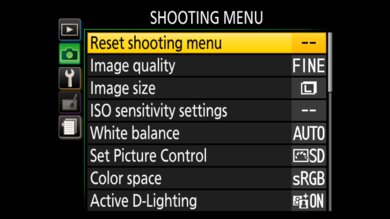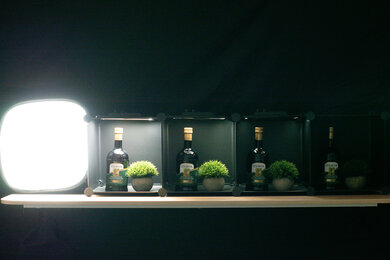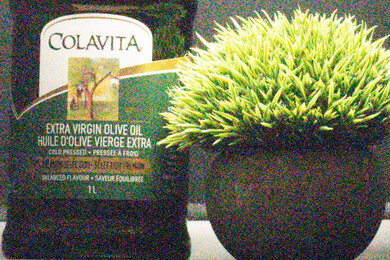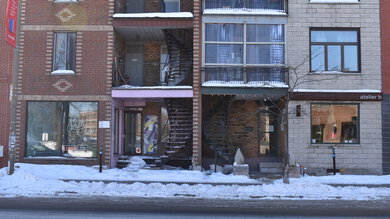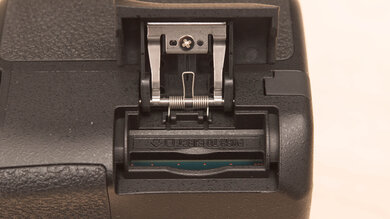The Nikon D3500 is a simple DSLR with an APS-C sensor. First released in 2018, it's very similar to previous models in Nikon's D3000 series of beginner DSLR cameras, offering incredible ease of use and a Guide Mode that can walk beginners through the basics of photography. All in all, it's a simple and lightweight DSLR that can capture high-quality images—but you'll have to look to higher-end models or newer mirrorless cameras if you want 4k video, a super quick burst rate, or more sophisticated autofocus.
Our Verdict
The Nikon D3500 is decent for travel photography. Its sensor punches above its weight, with solid image quality and good dynamic range for an entry-level APS-C camera. Battery life is fantastic, too, so it can easily last through long days on the go. It's also one of the most portable DSLRs around. That said, it's still relatively bulky compared to mirrorless alternatives, and the autofocus system is pretty basic, with focusing limited mostly to the center of the frame and unreliable tracking for fast subjects.
- Great image quality.
- Fantastic battery life.
- Guide Mode for new users.
- Basic autofocus system with limited tracking capability.
- Plastic construction.
- Not the most portable option.
The Nikon D3500 is decent for landscape photography. It performs fairly well for an APS-C camera, with good dynamic range to capture a wider range of highlight and shadow detail. Its noise performance is also adequate, though noise becomes apparent in trickier lighting conditions. It's also comfortable to shoot with and quite portable for a DSLR. The camera doesn't feel especially sturdy, with cheap-feeling plastic construction. It also has a fixed screen, making it harder to get shots from lower angles.
- Great image quality.
- Fantastic battery life.
- Guide Mode for new users.
- Plastic construction.
- Not the most portable option.
- Noise handling is just okay.
The Nikon D3500 is okay for sports and wildlife photography. Its max continuous shooting speed is slow, making it difficult to capture clear shots of fast-moving subjects. Its autofocus system is also somewhat basic, with focus points limited to a central cluster, meaning you can't track subjects to the edges of the frame. It can also struggle to keep up with faster or more erratic subjects. On the upside, the image quality is great, and the camera has a fantastic battery life.
- Great image quality.
- Fantastic battery life.
- Guide Mode for new users.
- Basic autofocus system with limited tracking capability.
- Plastic construction.
- Slow burst rate.
The Nikon D3500 has decent RAW photo performance. Its sensor has good dynamic range, so it can capture a fairly wide array of detail in high-contrast scenes. It has a relatively high-res sensor, so images appear reasonably sharp and detailed. However, its low-light noise handling is just okay, as it struggles a bit more with noise in trickier lighting, where you may have to bump up your ISO.
- Good dynamic range.
- Noise handling is just okay.
The Nikon D3500 isn't meant for vlogging. Its screen is fixed, so you can't see yourself when the camera is held in a selfie position. It's also somewhat bulky, so it isn't ideal for walk-and-talk vlogs. It also can't record 4k video and has a limited autofocus system.
- Fantastic battery life.
- Basic autofocus system with limited tracking capability.
- Fixed screen.
- No 4k video.
The Nikon D3500 is a poor choice for studio video, though it isn't intended for this use. For one thing, it can't record in 4k, and the quality of 1080p videos isn't amazing due to the camera's limited internal recording capability. It also lacks inputs and outputs, with no microphone or headphone jacks.
- Fantastic battery life.
- Basic autofocus system with limited tracking capability.
- Limited selection of inputs and outputs.
- No 4k video.
The Nikon D3500 isn't designed for action video. It's too big to mount on a helmet or chest rig and doesn't have any kind of water resistance. It also can't record in 4k and isn't capable of recording at high frame rates for fast action and slow-mo video.
- Fantastic battery life.
- Plastic construction.
- No high frame rate options.
- No 4k video.
Changelog
- Updated Jan 29, 2024: Added text to the 'Raw Photo Performance' verdict box.
- Updated Jan 29, 2024: Converted to Test Bench 0.12.1.
- Updated Aug 23, 2023: Added link to the Canon EOS R100 in the 'Menu System' section to provide an alternative with many automatic scene modes.
- Updated Apr 05, 2023: Converted to Test Bench 0.12.
Check Price
Differences Between Sizes And Variants
The Nikon D3500 is only available in one color variant: 'Black', and you can see our unit's label here.
You can buy the camera in a bundle with the Nikkor AF-P DX 18-55mm f/3.5-5.6G VR lens or other lenses like the AF-P DX Nikkor 70-300mm f/4.5-6.3G ED lens, depending on the retailer. You can also buy it without a lens at all.
Let us know if you come across a different variant of this camera, and we'll update our review.
Popular Camera Comparisons
The Nikon D3500 is a simple entry-level DSLR from 2018. It doesn't have a lot of bells and whistles compared to more advanced models, especially newer mirrorless cameras, meaning you won't find things like 4k video capability or even a tilting screen here. However, it has a unique 'Guide' shooting mode that can walk you through the basics of photography, making it a standout option for beginners.
If you're looking for more options, check out our recommendations for the best cameras for beginners, the best DSLR cameras, and the best cameras under $1,000.
The Nikon D3500 is better overall than the Canon EOS Rebel T7/2000D. While both are entry-level cameras with some of the same limitations, the D3500 has a better sensor, resulting in slightly better overall image quality. It also has a faster max burst rate, a significantly longer battery life, and a built-in 'Guide Mode' to walk beginners through the basics of photography.
While the Sony α6000 and the Nikon D3500 are both entry-level cameras, they use different camera technologies with different advantages. The Sony is an older mirrorless camera, so it's much more portable than the Nikon. It also has a quicker autofocus system, a faster burst rate, and a tilting screen. The Nikon, on the other hand, is a DSLR, so it has a much better battery life, and its optical viewfinder gives you a clearer, lag-free view of your subjects. It also comes with a 'Guide Mode' to walk new users through the basics of photography.
The Nikon D5600 sits above the Nikon D3500 in Nikon's DSLR lineup. Both use a similar sensor and are compatible with the same DX lenses, but the D5600 has some extra features that make it better overall. These include a more advanced autofocus system, an articulated screen, a mic input, and more wireless connectivity options. That said, the D3500 has a longer battery life and a unique 'Guide Mode,' making it a great choice for beginner photographers.
The Canon EOS Rebel T8i/850D is better overall than the Nikon D3500. It has a slightly more capable sensor, a faster max burst rate, and a more advanced autofocus system, along with extra features like 4k video capability and a fully articulated touchscreen. That said, the D3500 has a unique 'Guide Mode' to help new users grasp the basics of photography, meaning it may be preferable for absolute beginners.
Test Results

The Nikon D3500 is relatively small and lightweight for a DSLR camera. Even among APS-C options, it's one of the most lightweight that we've tested, weighing a little less than even the Canon EOS Rebel SL3. That said, it's still bulkier than mirrorless alternatives like the Canon EOS M50 Mark II.
The Nikon D3500 feels fairly comfortable in the hand and will be suitable for most hand sizes. The handgrip is nice and textured, with a fair amount of room. There aren't many dedicated dials or buttons, which makes sense for beginners, but makes it harder to adjust settings on the fly if you're shooting in manual mode.
The camera uses a fixed screen, which makes it harder to shoot from different angles. It also lacks touch capability, meaning you have to navigate the menu and adjust settings using the D-pad and buttons. The screen doesn't get especially bright, which makes it harder to review your images on sunny days.
The camera's menu is simple and easy to use thanks to the camera's more basic feature set. Unfortunately, the screen isn't touch-capable, so you have to navigate settings using the physical controls. Still, the settings are relatively limited, so it isn't a complicated experience. There aren't many customization options, which isn't surprising given the camera's limited controls. Overall, it's very well-suited for beginners but may be too limited for advanced users. If you're looking for a beginner-oriented camera with a wider array of automatic shooting modes, check out the Canon EOS R100.
Battery life in photos is fantastic. While CIPA ratings are to be taken with a grain of salt when compared to real-world usage, they give a good indication of how different cameras perform relative to one another. The Nikon D3500 lasts longer than a higher-end entry-level model like the Nikon D5600; however, it's still shorter than high-end models like the Nikon D780 or even some competitors like the Canon EOS Rebel SL3. Still, it's miles ahead of mirrorless alternatives.
Video battery life is also excellent, lasting for roughly two hours of continuous 1080p video recording.
Continuous shooting is very limited. Its max burst rate isn't very quick and only has one speed option. Its photo buffer also isn't very large, especially when shooting in RAW, but thankfully it's very quick to empty once full.
The Nikon D3500 has a relatively rudimentary autofocus system overall. It's fairly limited as far as coverage goes, with just 11 focus points clustered around the center of the frame. That's especially limited compared to more intermediate models like the Nikon D5600, which has 39 detection points, and even more so compared to mirrorless alternatives, which typically have AF coverage across most of the frame. That said, for an entry-level model, it isn't bad, especially with slower subjects, but it can struggle to keep up with fast-moving or erratic subjects.
The results were achieved using the viewfinder rather than Live View. When shooting through the viewfinder, the camera uses Nikon's '3D Tracking', which uses information from the scene and predictive algorithms to track a selected subject as they move across the frame. We found viewfinder autofocusing to be generally quicker and more accurate than in Live View.
Despite having a more limited tracking feature, the autofocus is still very effective when using the center focus point. Overall, the AF is quick and reliable and works very well for still subjects as well as subjects moving at a moderate pace, though it doesn't always nail the focus with quicker subjects.
There's no in-body sensor stabilization on this camera, but you can use optically stabilized lenses, which use what Nikon calls 'VR' or vibration reduction. Depending on the lens, focal length, and how steady your hands are, you can get stable shots at very slow shutter speeds with this camera.
The dynamic range is good. It's on par with other entry-level DSLRs with APS-C sensors, though it falls short of newer mirrorless models like the Nikon Z 50. Still, you can capture a fairly wide range of highlight and shadow detail, especially in scenarios where you have more available light.
The Nikon D3500 has a 24.2-megapixel sensor that does a decent job resolving fine detail, though it isn't as sharp and detailed when you punch in as newer mirrorless cameras like the Nikon Z 50.
RAW noise handling is okay. It's a bit worse than peers like the Canon EOS Rebel SL3 or the step-above Nikon D5600, especially when there's less available light and you have to use higher ISO settings. However, it's still quite good for an APS-C camera when using low to moderate ISOs.
This camera can record 1080p video at up to 60 fps, so you can create 2x slow-motion video or record smooth fast action.
Internal recording capability is just okay relative to newer mirrorless cameras. The max recording time is somewhat short, and bit rates are low, resulting in lower-quality video.
The autofocus performs poorly in video mode. It isn't very good at tracking moving subjects and struggles to keep up with them. That said, it's an entry-level DSLR, so this isn't the camera's forte and isn't out of the ordinary.
Video quality isn't great, resulting in videos lacking in sharpness and detail. That said, it does a passable job in low light. Details are still muddy, and you'll see some noise, but it isn't bad relative to a camera like the Canon EOS Rebel SL3.
There isn't too much rolling shutter effect when panning the camera, though you'll still notice some skewing or distortion when moving the camera very quickly.








